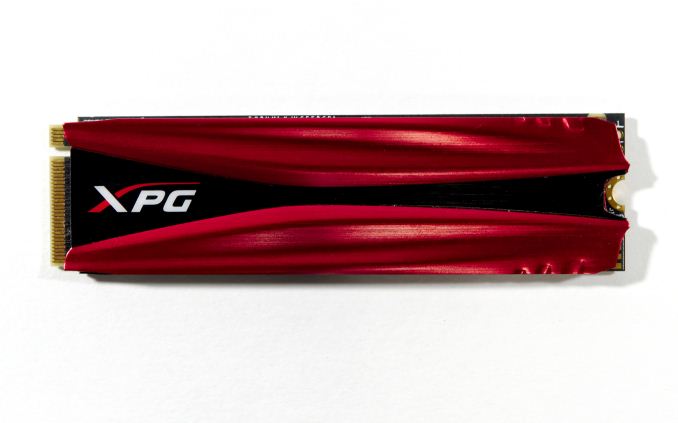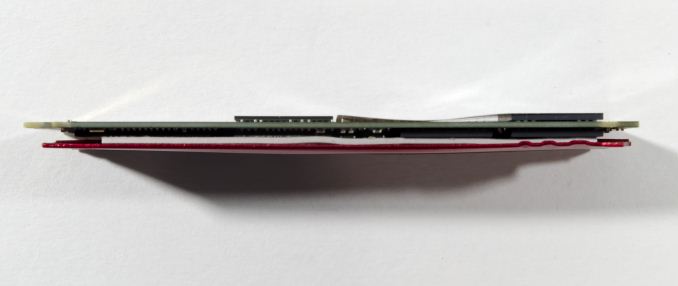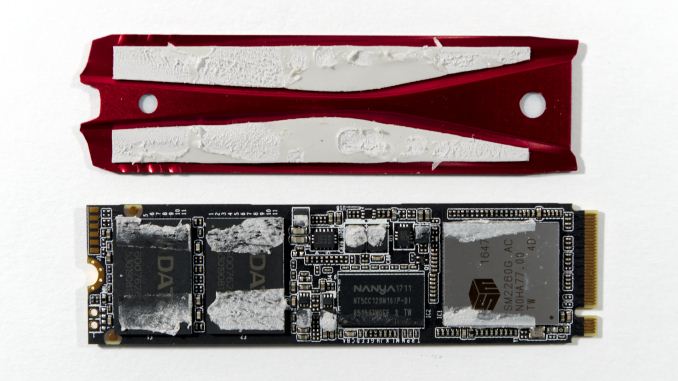The ADATA XPG GAMMIX S10 (512GB) SSD Review: Entry-Level NVMe With Style
by Billy Tallis on October 25, 2017 8:30 AM EST
The ADATA XPG GAMMIX S10 is a M.2 NVMe SSD with very enthusiast-oriented branding and packaging, but it isn't even close to being ADATA's top NVMe SSD. Instead, it's a derivative of their entry-level XPG SX7000 M.2 NVMe SSD, adding only a heatspreader. Underneath, the SX7000 and the GAMMIX S10 both use Micron 32-layer 3D TLC NAND with the Silicon Motion SM2260 controller. This combination is also used in the Intel SSD 600p, which has been one of the cheapest NVMe SSDs on the market.
The Silicon Motion SM2260 controller is their first NVMe SSD controller. SMI's initial aspirations for the controller were high, but it has instead found its niche as the cheap but slower option. The SM2260 was the first NVMe controller to offer a turnkey firmware solution for use with Intel/Micron 3D NAND. That allowed Silicon Motion to win back some market share from from Phison, whose controllers including the PS5007-E7 NVMe controller are largely tied to Toshiba NAND. This is an important distinction as Toshiba's 3D NAND has yet to make an appearance in any third-party SSDs. For SSD vendors that source both NAND and controllers on the open market, Silicon Motion and Micron have been the only 3D NAND option for the past year.
The Intel/Micron 32-layer 3D NAND flash memory was the second 3D NAND to ship in volume (after Samsung's V-NAND), and the first to be widely available on the open market, as Samsung uses most of their flash for their own SSDs. Micron's 3D NAND has proven to be slower than Samsung's, but reasonably power efficient when paired with the right controller. It is also fairly cost-effective, and SSDs with Intel/Micron 3D NAND have been dominating the value SSD market for more than a year.
A new generation of Silicon Motion NVMe controllers has been announced but is still months away from being ready to hit the shelves. The 64-layer Intel/Micron 3D NAND has seen a very limited release in the Intel 545s, but the flash used by the ADATA XPG GAMMIX S10 can't be replaced yet. Meanwhile, ADATA is now able to buy Micron's 32-layer 3D NAND by the wafer and do their own binning and packaging. As their top TLC SSD, the GAMMIX S10 is likely equipped with the highest grade of 3D NAND that goes into ADATA's consumer drives.
| ADATA XPG GAMMIX S10 Specifications | ||||
| Capacity | 128 GB | 256 GB | 512 GB | 1 TB |
| Model Number | ASX7000NPC- 128GT-C |
ASX7000NPC- 256GT-C |
ASX7000NPC- 512GT-C |
ASX7000NPC- 1TT-C |
| Controller | Silicon Motion SM2260 | |||
| NAND Flash | Micron 384Gb 32L 3D TLC NAND | |||
| Form-Factor, Interface | M.2-2280, PCIe 3.0 x4, NVMe 1.2 | |||
| Sequential Read | 660 MB/s | 1370 MB/s | 1750 MB/s | |
| Sequential Write | 450 MB/s | 820 MB/s | 860 MB/s | 850 MB/s |
| Random Read IOPS | 35K IOPS | 70K IOPS | 130K IOPS | |
| Random Write IOPS | 95K IOPS | 130K IOPS | 140K IOPS | |
| Warranty | 5 years | |||
| MTBF | 2,000,000 hours | |||
The specifications for the ADATA XPG GAMMIX S10 are typical for an entry-level NVMe SSD. The 128GB model has severely reduced performance potential due to not being able to populate every channel of the controller with NAND flash chips, while the 512GB and 1TB models offer about the same performance. Despite having a PCIe 3.0 x4 link that is capable of almost 4GB/s, the GAMMIX S10 won't even hit 2GB/s. ADATA doesn't officially list write endurance, but the five-year warranty is a step up from what most entry-level SSDs offer, even in the NVMe market segment.
The heatspreader on the ADATA XPG GAMMIX S10 keeps to a fairly low profile, but isn't just a single sheet of metal. The main body of the heatspreader is red, and there's a recessed section down the middle that holds a black insert. On the underside of the heatspreader, this leads to thermal compound only being used on the outer edges of the heatspreader, and it makes very little contact with the controller itself. This heatspreader isn't purely cosmetic, but it will cool the drive much less than a first glance suggests it should.
The GAMMIX S10 is a double-sided M.2 card, with some DRAM, NAND flash, and smaller components on the back. Smaller capacities than our 512GB sample may omit the DRAM package on the back.
This review will compare the 512GB ADATA XPG GAMMIX S10 against a variety of NVMe and SATA SSDs. The closest competitors are mostly other NVMe SSDs using TLC NAND, so those drives have been highlighted in the bar charts.
| AnandTech 2017 SSD Testbed | |
| CPU | Intel Xeon E3 1240 v5 |
| Motherboard | ASRock Fatal1ty E3V5 Performance Gaming/OC |
| Chipset | Intel C232 |
| Memory | 4x 8GB G.SKILL Ripjaws DDR4-2400 CL15 |
| Graphics | AMD Radeon HD 5450, 1920x1200@60Hz |
| Software | Windows 10 x64, version 1703 |
| Linux kernel version 4.12, fio version 2.21 | |
- Thanks to Intel for the Xeon E3 1240 v5 CPU
- Thanks to ASRock for the E3V5 Performance Gaming/OC
- Thanks to G.SKILL for the Ripjaws DDR4-2400 RAM
- Thanks to Corsair for the RM750 power supply, Carbide 200R case, and Hydro H60 CPU cooler












27 Comments
View All Comments
rrinker - Wednesday, October 25, 2017 - link
For some reason I thought the black insert was plastic, but it actually doesn't say either way. If plastic, well... You pretty much said what I was skirting around, it's all cosmetic like so many of the weird and funky heat sinks/heat spreaders you see on "enthusiast" gear. There to look cool, doesn't actually do much of anything, either because it's not really needed, the device with the heat sink doesn't actually get all that hot, or it's no more effective than a plain old simple heatsink.Wwhat - Sunday, November 12, 2017 - link
I am absolutely perplexed that anandtech doesn't specify the material of that insert. I mean that is so goddamn relevant.And I'm actually wondering what adata's comment on that insert would be. They should have asked them.
As for needed, all tests have shown a good heatsink on the M2 SSD's does indeed do a world of good. And tests have also shown that half the companies in the world that supply such, either bundled or third party, can't figure out such a simple thing as a piece of aluminium on a freaking small rectangle. I mean how complex is it? But again it's been shown that if you put a good one on it it's always noticeably beneficial.
jjj - Wednesday, October 25, 2017 - link
Don't understand how one imagines a product with that seq read perf.trparky - Wednesday, October 25, 2017 - link
I went to go look at what you were talking about and my first reaction when I saw the graphs was "Ouch! WTF!". It barely matches the performance of a SATA SSD, putting it on NVMe is just a waste.r3loaded - Wednesday, October 25, 2017 - link
If your product is going to get curbstomped in performance by the 960 Evo, at least try to price it at a significant discount vs the 960 Evo.ddriver - Wednesday, October 25, 2017 - link
It is very hard to undersell samsung, they make the memory, they make the controller, they make the pcb. Vertical integration.Now imagine that you have to buy each of those components from someone else, pay profit margins on the components, then put work into making a product out of it, and sell that product with a profit margin for yourself.
It is a pointless endeavor. In a better world, they won't even bother to compete with a vertically integrated company like samsung. But in the world as it is, there are plenty of idiots who will buy this, one way or the other, either for the gimmicky but nice looking heatsink, or it will get it shoved down their throats by an OEM who has a deal with the manufacturer to bundle the product.
The negative aspect of this is that after so many years of domination, samsung will significantly cut on the purchase value of their products, because it still has tremendous lead and could let some of it melt in order to materialize as profits. Upcoming SSDs from samsung, even if a tad faster, will be disappointing compared to what we used to get in the past. Get ready for a slump of TLC and QLC, endurance and warranty period cuts.
Ratman6161 - Wednesday, October 25, 2017 - link
People aren't idiots. They are just uninformed. There is a big difference. For my uninformed friends who either can't or don't want to do the research, my recommendation is always "just buy Samsung and don't worry about it". Or if they want reasonably priced but larger storage with "OK" performance then it's "just buy Crucial and don't worry about it.If you know specifically what you are looking for and know what trade offs you are willing to make there are other choices that fit certain niches. But even knowing what I wanted/needed I ended up with a 512 GB 960 EVO and a 750 GB MX300 (got on prime day last year for $139 :)).
ddriver - Wednesday, October 25, 2017 - link
"People aren't idiots. They are just uninformed."Tomayto, tomahto... If you make a purchase uninformed, that's idiocy right there.
IMO everyone is an idiot, including me. It is not a matter of idiots or non-idiots, at this stage of evolution we are all idiots, it's just that some are more idiotic than others. And the first step to overcoming idiocy is to acknowledge it :) The gradation of idiocy is acknowledgement of it, ignorance of it, mistaking it for something else and finally taking pride in it.
Lolimaster - Wednesday, October 25, 2017 - link
For sata the WD/Sandisk 3D SSD's seems a like a better option than the Crucials.KAlmquist - Friday, October 27, 2017 - link
A vertically integrated company like Samsung still wants to make a profit on its investments into R&D, so the fact that all of the R&D is done by one company doesn't directly help costs. It does remove some of the costs associated with developing and maintaining relationships between companies. For example, Silicon Motion has to market its products to SDD manufacturers, which is an overhead that Samsung's controller development group doesn't have. Another possible cost savings for Samsung is that it knows it's controllers will never be used with anything other than Samsung flash, so it doesn't have to develop a controller that is compatible with multiple brands of flash.